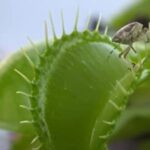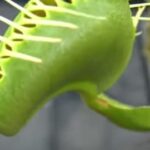As an Amazon Associate, this site earns commissions from qualifying purchases. For more details, click here.
We know that Venus flytraps will eat insects and other animals that fall into its trap. But what happens afterwards? Does the plant produce waste material like animals do? Do they eat all of the prey or leave some behind? The answer is not as straightforward as it seems. But no worries as this article will explain.
When a Venus flytrap catches a prey, it releases enzymes to dissolve the soft tissues. When the trap opens again, the inedible parts are left out and can be considered as waste material.
Do Venus Flytraps Excrete Waste?
It depends on how excrement, waste or poop is defined. If we mean an orifice specifically for removing waste, the answer is no, Venus flytraps do not poop. But if this refers to discarding of waste material through any way, then yes, Venus flytraps do produce waste.
Venus flytraps do not actually “eat” insects. Once a bug is caught, the plant produces enzymes that melt the insect so it can be ingested. Insects are rich in nitrogen and other elements which Venus flytraps use as nutrients.
Some insects have a hard exoskeleton which the enzymes cannot break down that easily. The plant will consume the soft tissues but leave the exoskeleton behind as leftovers.
After several days, the trap will reopen and the remains of the insect are all that is left. It is correct to say that the remains are waste material which the plant has discarded.
Of course there are other ways to look at this process. If you look at the trap as a mouth, it would be more accurate to say that Venus flytraps spit out or do not eat parts which do not benefit them. So it really comes down to how poop is defined.
For Venus flytraps to dispose of waste, they must have healthy roots. They should also have enough food and sunlight so its traps grow. The soil needs to be moist but Venus flytraps must not be overwatered.
One of the reasons why many people do not accept the idea of Venus flytrap poop is plants do not have digestive systems. While carnivorous plants consume insects, they do not digest them the way other animals do.
Regardless, Venus flytraps do leave some liquids after eating a plant. If you look closely you will see some of the enzymes left over and probably insect bits as well. This can qualify as waste material the plant has disposed of.
What Happens to Venus Flytrap Poop?
No matter what prey gets into a Venus flytrap, the plant will consume it the same way. The trap produces enzymes that liquefies the insect so the plant can absorb its nutrients. So if you give it Tetra Freeze Dried Bloodworms for example, the plant will process it the same way it would an insect.
After a Venus flytrap eats a bug, its carcass is left on the trap where it gets washed away by the rain or carried by the wind. If the plant is indoors, the leftover will remain there until it is disposed of or eaten by bacteria.
Once all the nutrients are taken in, the trap will open again. The plant will try to dissolve as much of the food as it can. If this is not possible those parts are going to discarded.
If your Venus flytrap is outdoors, nature will take of the remains. Rainfall will wash the carcass away or winds will blow it into the distance.
During summer days, the remains will quickly decay and attract bacteria. They will consume whatever is left of the bug. Any one of these – bacteria, rain, wind – will remove the poop.
If you do not want insect carcasses on your Venus flytrap, there are alternatives. You can feed them mealworms as it has the nutrients Venus flytraps need to grow even without any insect food.
How to Eliminate the Odor
Of course we cannot talk about poop without bringing up the smell. Fortunately it is a non-issue here as the remains are so small the odor is negligible.
The average trap is 1.1-.5 inches long, so it cannot hold a large bug. If a large insect steps onto the trap it will not close at all.
The smaller the bug, the less poop will be left over. To put it another way, the exoskeleton of a one inch insect is not going to leave a strong odor unless you get very near to it.
The only possible problem is if a large cockroach or earthworm finds its way into the trap. If it cannot escape and dies half of its body will stick out of the trap and rot. This could produce a nasty odor especially if it is a worm. In this case you will want to remove it.
Of course the sight of gutted insect bits and goo is unappealing. But you can easily remove these with tweezers or other tools. Just be careful not to trigger the sensors or the trap will close. We suggest BinaryABC Tweezers because they have a long handle and easy to use.
If the insect remains do not bother you, you can just leave it there. Eventually microorganisms will take over and dispose of it. And there is no need to worry about bacteria going after your Venus flytrap as they will only consume the insect.
How to Avoid Waste Buildup in Venus Flytraps
If you only have one or two Venus flytraps, poop management is not a big deal. But what if you have several of these plants in your home? That will not be a problem either as there are many simple ways to handle plant poop.
The following tips are for Venus flytraps, but they are applicable for other plants as well. You can also use these methods to remove food bits and debris in the soil.
Keep Venus Flytraps Outside
This is the easiest solution and most practical. Let your Venus flytraps grow outdoors and nature will handle everything.
There will be plenty of insects for your carnivorous plants to feast on. No need to do any feeding on your part as Venus flytraps usually eat insects once every 1-4 weeks. There should be many of those outside your home.
And when your plants are done eating, nature will remove the remains. Just about the only thing you have to do is make sure the plant is well placed to receive sunlight.
If you keep Venus flytraps outdoors, there is no need to do any poop cleanup. This is the best choice especially if you have several Venus flytraps or carnivorous plants.
Resist the temptation to feed Venus flytraps when they are outdoors. There is already a lot of insects that will meet its nutritional needs.
Manage Poop For Indoor Venus Flytraps
If your plants are inside, there are several things you can do to manage waste. Here are some suggestions.
- Do not feed it insects with had shells.. Beetles and cockroaches have very tough shells that are hard to dissolve. Give the plant small bugs that it can easily consume and you do not have to deal with too much waste.
- Do not worry if your Venus flytrap only eats a few houseflies or spiders a month. The occasional insect in your home is usually enough for the typical Venus flytrap.
- Do not overfeed. The rule of thumb with Venus flytraps is that only one trap should be fed at a time. This is enough to supply the plant with the nutrients it needs.
Too much food is not good for Venus flytraps. It exerts a lot of energy to digest food and too much is unhealthy. Not only that but you also have to deal with more poop.
The less food you give it, the less poop will be left behind. And do not worry about lack of nourishment as they do not need to eat a lot of insects. If you see some bits left over in one of its traps, just pick it up with a pair of tweezers, again careful not to set off the hair triggers.
Check for Signs of Rot in Your Plant
If you notice a smell coming off your Venus flytrap, check if it is coming from the remains of the bug or the plant itself. If the odor seems to come from the plant, examine it carefully. Look for signs of leaves losing color or traps that refuse to open. These are symptoms of root rot and must be taken care of. Root rot can spread throughout the plant so if necessary, check its bulb.
If you are sure it is not root rot, it could a bug or worm that died and fell into the soil. Check around the plant, and it should not be hard to trace the source of the smell.
Conclusion
Venus flytraps continue to enthrall people because of their nature. Even something as mundane as poop becomes an interesting discussion concerning its disposal and how it should be managed. And the more you know, the better you can take care of your Venus flytrap.

My fascination with carnivorous plants began many, many years ago with Venus Fly Traps. Now I am more than happy to impart what I know with other enthusiasts and those who are curious about meat eating plants.



